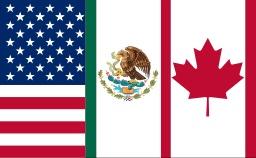
The news is full of talk about trade agreements. For decades, US trade policies have been designed to benefit corporations while hurting workers in the United States and elsewhere. Will new tariffs and trade agreements make things better or worse? As of this writing, it is too soon to know.
Those of us on the left have been protesting free trade agreements almost since their inception. In the 90s, politicians promised that trade liberalization agreements, such as the North American Free Trade Agreement (NAFTA) and the Central American Free Trade Agreement (CAFTA), which eliminated tariffs on key commodities, would promote bilateral economic growth, yielding job creation and prosperity for workers on both sides of the border. Instead, in the decades since NAFTA, this trade policy has fueled displacement and exacerbated inequality in the interest of securing deregulated markets to protect corporations. Ultimately, these trade agreements have triggered a “race to the bottom” in wages and working conditions and led to the off-shoring of US companies in search of cheaper labor.
Maquiladora jobs at export-focused garment and textile factories across Mexico and Central America are a prime example of this “race to the bottom” provoked by NAFTA. The removal of import taxes incentivized US corporations to offshore nearly 950,000 US jobs to decrease labor costs. This not only led to massive job loss in the US but, taking advantage of lax labor laws and enforcement, US firms sought to maximize profits by paying low wages to workers in Mexico and Central America while selling their goods on the US market.
People in maquiladoras work without protections in extremely dangerous conditions, earning a fraction of what US workers would earn for the same work. Average annual wages have declined in Mexico under NAFTA, and those making the least have been hurt the most, with the minimum wage declining by 8.3 percent. With millions of Mexicans competing for a limited number of manufacturing jobs, employers can keep wages deplorably low.

Although maquiladoras began in the 90s, this model of labor exploitation continues today because NAFTA and CAFTA are fundamentally policies designed to extract profits for US corporations rather than build resilient industries with fair wages. With China's WTO accession in 2001, many firms abandoned Mexican plants for Chinese factories offering labor at less than $1 per hour. This made things worse, provoking a sharp decline in exports and maquiladora jobs, and leaving many unemployed.
NAFTA not only led to workplace exploitation and unemployment, it also devastated Mexico’s agricultural sector. By eliminating tariffs on key crops like corn, wheat, and soy, NAFTA led heavily subsidized US agribusiness giants to flood Mexican markets with artificially cheap agricultural products sold below the real price of production. As a result of this unfair competition, prices for Mexican produce collapsed by 66%, and over 2 million small farmers lost their livelihoods in the first decade of NAFTA. This deepened rural poverty in states like Oaxaca, Chiapas, and Guerrero.
Unsurprisingly, these same regions of Mexico later saw some of the highest migration rates to the United States. NAFTA, instead of improving living standards in Mexico as promised, hollowed-out wages, exacerbated extreme economic precarity and inequality, and forced millions of farmers and garment workers to migrate in search of survival. During NAFTA’s first six years, the number of annual immigrants from Mexico to the US more than doubled, coinciding with a flood of US subsidized corn into Mexico.
The collapse of Mexico’s farming industry and the proliferation of low-wage maquiladora jobs are just two examples of how free trade policies drive migration. NAFTA’s legacy includes environmental degradation, the dismantling of communal land systems “ejidos”, the decline of domestic manufacturing, and the erosion of agricultural self-sufficiency, all of which have contributed to displacement.
Migration, then, is not a “border crisis,” but a predictable outcome of our own trade policies.
Furthermore, the insecure immigration status of migrants displaced by NAFTA allows the giants of the agriculture, construction, meatpacking, dairy, and garment industries in the US to exploit them for underpaid and unsafe labor, preying on workers' fear of deportation to prevent them from speaking up or unionizing. These same industries also spend millions lobbying for restrictive immigration policies that maintain a steady flow of vulnerable workers, ensuring they don’t have to rely on hiring citizens or legal residents at fair wages. There is an 83% chance that any garment made in America was made in Los Angeles by exploited immigrant labor.
Immigrants are then scapegoated, accused of “stealing American jobs,” and used as political weapons to obscure the real issue: free trade policies that support corporations while hurting domestic and foreign workers.
Why is this particularly relevant now?
The current administration claims to dislike free trade agreements and support tariffs, and yet they are negotiating new trade agreements that are supposed to reduce or eliminate threatened tariffs. While it is too soon to know the outcome of current negotiations, and we want to keep an open mind, we remain skeptical that the outcome will turn out better for workers.
The 2020 renegotiation of NAFTA updated the agreement without changing its exploitative structure or delivering any real improvements for the working class, simply rebranding it as the USMCA (US Mexico Canada Agreement). The new agreement still protects corporate profits and US agribusiness, suppresses wages, and expands monopoly rights. Crucially, USMCA continues to prioritize the interests of large corporations over rural workers in all three countries.
The USMCA included modest improvements such as the “Rapid Response Mechanism” that enables workers’ organizations to petition the US or Canadian government regarding specific abuses in Mexican factories that deny collective bargaining rights, with a response required by the respective governments within a specified timeframe. However, with exploitative structures still in place across the system, the “race to the bottom” remains alive and well.
Therefore, as the mandatory, once-every-six-years review of the USMCA approaches in July 2026, workers and workers-rights groups on both sides of the border are gearing up to make sure their demands are heard.
Here are some concrete changes that workers and their communities would like to see in the upcoming USMCA review:
- Establishing a manufacturing minimum wage in Mexico so that corporations can no longer force workers to accept less on either side of the border.
- Removing corn and beans from the treaty so that Mexican farmers have a chance at earning a fair living without subsidized US agribusiness flooding the market.
- Ensure that multinational corporations are subject to national courts. Remove foreign investor rights and Investor-State Dispute Settlement (ISDS) provisions that allow corporations to challenge human rights protections.
- Recognize indigenous autonomy in the face of extractive projects on their ancestral lands and create a trinational fund to compensate for environmental losses and damages.
- Implement transparent and inclusive policymaking processes. Center the voices of migrant and working class communities instead of corporate-dominated trade advisory committees. Publicize negotiation texts.
For further reading and policy recommendations please check out the extensive report Exporting Instability, Importing Exploitation written by Iza Camarillo and jointly published by Public Citizen and the National Partnership for New Americans (NPNA). The United Auto Workers have also published a separate set of demands for the USCMA review.
The Quixote Center is participating in coalitions advocating for changes in the USMCA and has already signed one letter calling for specific amendments. Current trade policy is confusing and changing quickly, but we will do our best to keep our supporters informed. We think that protectionist policies (tariffs) probably make sense for some commodities and not for others. The devil is always in the details.
Thumbnail photo from Wikimedia Commons: Keepscases, CC BY-SA 3.0



Comments
Robert Fritsch (not verified)
This is just one more example of corporate greed in the form of actually abusing foreign labor for the sake of profit. Foreign labor, ofter people of color from impoverished areas have to endure often dangerous work conditions, abuse and high attrition rates while higher paid U.S. workers lose their jobs. NAFTA was a lose-lose situation except for the corporations.
Quixote Center (not verified)
Yes, exactly. Thanks for your comment.